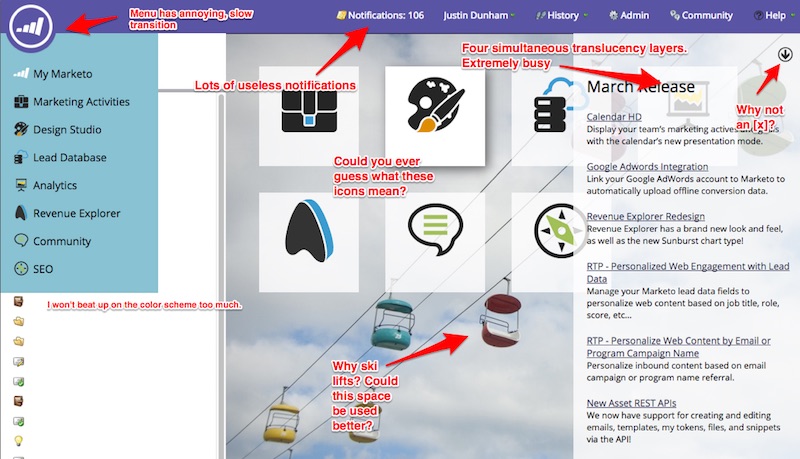Why does enterprise software look so bad?
April 2, 2015
I’ve become a big user of enterprise software in the past couple years. The design of most enterprise software ranges from unattractive to hideous. Color schemes don’t make a lot of sense. There’s no whitespace. Interfaces are busy and unintuitive. There isn’t any sense of fun, either.
I’ve seen a few explanations for this. All of them seem like they’ll go away pretty soon.
“Enterprise vendors have no taste”
A recent post on Hacker News speculated that enterprise software looks bad because enterprise software vendors have no taste. That’s probably true. Certainly it’s easy to point to lots of examples of bad-looking and difficult-to-use enterprise software.
But if the vendors have no taste, or at least don’t have the resources to be tasteful, why is that? There are plenty of great designers and UX people out there; why don’t enterprise software vendors hire and listen to them?
Vendors are motivated to create software that sells. So why doesn’t design sell?
Enterprise software has to do a lot
This argument was also advanced in a Hacker News thread. The idea is that because enterprise software is essentially a construction kit, and because it has to work across so many types of businesses and use cases, it’s harder to make it look nice.
This would make sense as argument if it were purely about usability. Building powerful software that also exposes many powerful features in an easily-comprehensible way is indeed difficult. And enterprise software tends to have more features than other types of software.
However, it doesn’t really explain the more design-oriented aspects of this problem, especially when non-adminstrative users are dealing with the software. It also doesn’t explain some of the truly egregious design decisions that are made. Check out the front page of Marketo’s software, for example. It presents almost no functionality, is badly designed, and isn’t customizable.

Also, there are lots of enterprise-y software packages that are intended for less sophisticated users, that are still designed reasonably well. Compare Microsoft Office, for example, to SuccessFactors.
The users aren’t the buyers
Jason Fried’s explanation seems like a plausible one.
The people who buy enterprise software aren’t the people who use enterprise software. That’s where the disconnect begins. And it pulls and pulls and pulls until the user experience is split from the buying experience so severely that the software vendors are building for the buyers, not the users. The experience takes a back seat to the feature list, future promises, and buzz words.
In enterprise software, there’s a disconnect between people who will use your software, and the people who buy it. That there are some great-looking enterprise software products, like Slack, actually reinforces this idea: those products are almost invariably purchased by the end-user, or are at a relatively low price point. Having an end-user that is also the buyer doesn’t guarantee good design, but it allows for it.
This doesn’t make sense over the long-term
This doesn’t seem like a stable equilibrium, though. There are a bunch of hidden, but very quantifiable, benefits to good design (and good usability):
- Reduced reliance on help desks. Well-designed software makes it easy to remember how to do things, and makes errors more difficult to make and easier to recover from.
- Increased productivity. Software that “gets out of the way” and doesn’t present the user with obviously bad design allows tasks to be completed faster, and are less cognitively taxing for users.
- Increased feature finding. If features are laid out in a sensible way, and thought is given to presenting options and related tasks carefully within each view, more of the software can actually be used. According to this infographic, about a quarter of SaaS churn is caused by poor onboarding.
- Reduced training costs. More intuitive software is easier to learn.
- Decreased abandonment rate. Avoiding user frustration means that there are more advocates within the organization for your software.
It seems as if these factors, and others, would eventually influence economic buyers. Users who are getting more out of software, and are more productive with it, mean that the software is more valuable. My guess is that over the long term, enterprise software won’t have the luxury of looking bad anymore.